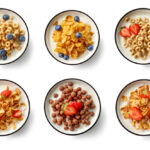SHOCKING: Toxic chemical linked to reproductive harm found in oat-based cereals
 (NaturalHealth365) Many food products in grocery stores are promoted as “healthy,” but upon closer examination, they may not be as beneficial as advertised. Some of these foods contain hidden sugars or are packaged in toxic materials, posing potential risks to our health.
(NaturalHealth365) Many food products in grocery stores are promoted as “healthy,” but upon closer examination, they may not be as beneficial as advertised. Some of these foods contain hidden sugars or are packaged in toxic materials, posing potential risks to our health.
The Environmental Working Group (EWG) conducted independent testing to investigate the presence of a toxic chemical – chlormequat – in various oat-based cereal brands and other related products. The results of the study are concerning.
Disturbing News: Traces of chlormequat, a chemical used on ornamental plants, found in U.S. food supply
Chlormequat is a plant growth regulator used in sharehouses, nurseries, and greenhouses for ornamental plants. It is routinely used on hibiscus, osteospermum, begonia, poinsettia, and geranium. This organic compound has not been approved in the United States for use on any crops intended for human or animal consumption – but it hasn’t been banned either.
However, chlormequat is often used by farmers who apply it to grain crops, including oat, while growing. This is because it prevents them from bending, which makes harvesting easier. The substance then seeps into the oats and grains.
Recently, the Environmental Protection Agency (EPA) released a statement that they now permit traces of this toxic chemical in U.S. food. This includes barley and oats.
What are the dangers of chlormequat?
According to the EWG, researchers have linked exposure to chlormequat during pregnancy to the following:
- Disruption of fetal growth
- Nervous system harm
- Developmental delays during puberty
- Bone and head development alterations
- Decrease in the production of testosterone
- Metabolism disruption
- Inhibiting the efficiency of sperm motility
What did EWG’s investigation discover?
The investigation found dangerous levels of chlormequat in several oat-based food products sold in the United States. This includes some very popular brands that are marketed to children as well as adults.
With so much evidence showing how this toxic chemical may harm human health … the Food and Drug Administration should take action now to protect the public. Of the 13 non-organic oat-based granola, cereal, and other products, only one did not contain chlormequat.
The products that contained higher levels of the substance that exceeds the amount believed to be safe for children’s health are from lowest to highest:
- General Mills Honey Nut Cheerios
- General Mills Frosted Cheerios
- Quaker Simply Granola Oats, Honey, & Almond
- Quaker Chewy Dark Chocolate Chunk
- Quaker Oatmeal Squares Brown Sugar
- Good & Gather French Vanilla Almond Granola
- General Mills Cheerios Oat Crunch Oats n’ Honey
- General Mills Cheerios
- Quaker Oatmeal Squares Honey Nut
- Quaker Instant Oatmeal Maple & Brown Sugar
- Walmart Great Value Oats & Honey Granola
- Quaker Old Fashioned Oats
Kellogg’s Special K Fruit & Yogurt was also tested, but no chlormequat was detected.
How do you avoid chlormequat-contaminated food?
One of the best ways to avoid chlormequat and other toxic substances in your food is to choose organic foods. Of course, whole, fresh fruits and vegetables and lean meats are great, but when choosing your whole grains, choose wisely. Look for organic grains because that is your best bet to find food that is chemical-free.
Cutting out processed foods is another way to skip the chlormequat in your food. If you don’t have a lot of time to cook every night, you can always meal prep or find a service that has clean, organic meals you can freeze and then heat in the oven or stovetop.
Making smart food choices has become much more difficult over the past few years. Now we have to look out for foods that have toxic chemicals that can do great harm.
Sources for this article include:



